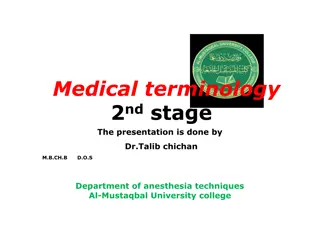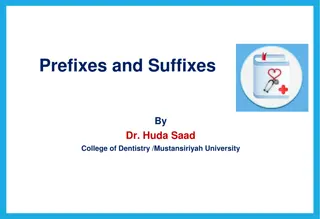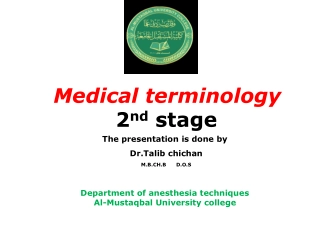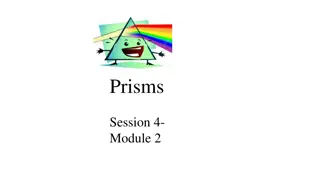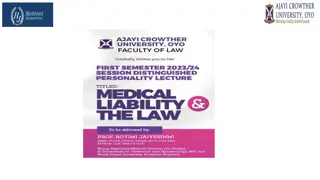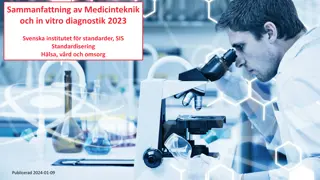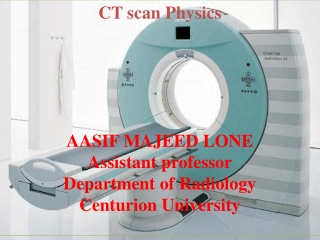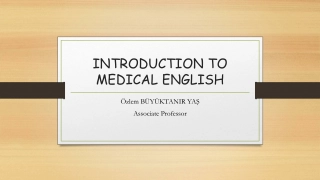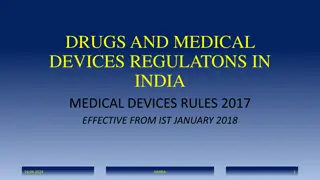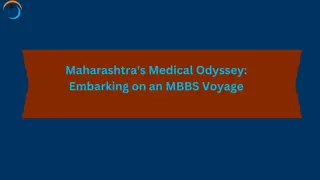Understanding Medical Terminology: Suffixes and Their Importance in Healthcare
Explore the significance of suffixes in medical terminology, how they modify word meanings, and the importance of dissecting terms to understand their components. Learn how suffixes denote conditions, aid in pronunciation, and convey crucial information in healthcare terminology.
Understanding Medical Terminology: Suffixes and Their Importance in Healthcare
PowerPoint presentation about 'Understanding Medical Terminology: Suffixes and Their Importance in Healthcare'. This presentation describes the topic on Explore the significance of suffixes in medical terminology, how they modify word meanings, and the importance of dissecting terms to understand their components. Learn how suffixes denote conditions, aid in pronunciation, and convey crucial information in healthcare terminology.. Download this presentation absolutely free.
Presentation Transcript
2024 - 2023 Medical Terminology denote condition or state Lecture :TWO and Three Dr. Ali Hussein Al-Nasrawi Otorhinolaryngologist specialty
Suffixes in Medical Terminology: Suffixes are added to the end of words and play various roles. They can indicate fields of study, diagnostic techniques, anatomical structures, physiological processes, medical conditions, or social standings. Suffixes can also determine whether a word is an adjective, noun, or gerundive. Dissecting medical terms
Importance of Suffixes Combining Vowels: Combining vowels, often "o," are used to make medical terms easier to pronounce. Breaking down a term into its parts can aid in understanding its meaning.
Example of Term Deconstruction: Illustrated with "hypothermia" as an example: Prefix "hypo-" means "below normal." Root "therm" means "heat." Suffix "-ia" denotes "condition."
Modifying Word Meanings: Words can have their meanings altered by attaching prefixes and suffixes to their root. Suffixes like "-er" and "-est" form comparative and superlative adjectives
Not All Suffixes Denote Condition Medical term requires knowledge of common medical roots, prefixes, and suffixes. In medicine, terms are always suffixed
Significance in Healthcare 1.A root is the fundamental part of a word. 2.Roots can be found at the beginning of a word, after a prefix, before a suffix, or between a prefix and a suffix. 3.Suffixes are added to the end of a word to convey meaning, such as a condition, disease, or procedure. 4.For example, the suffix "-itis" signifies inflammation, and when added to "cardi," it forms "carditis," meaning inflammation of the heart. 5.Every medical term must include a suffix. 6.Understanding common suffixes that denote conditions or states is crucial in medical terminology.
Learning Medical Terminology Learning Medical Terminology The suffix "-osis": describe diseases or conditions affecting specific organs or systems. Examples of medical terms using the suffix -osis: Arteriosclerosis: Hardening of the arteries. Cirrhosis: Liver disease. Osteoporosis: Decreased bone density condition. Tuberculosis: Disease caused by Mycobacterium tuberculosis. Osteoarthritis: Degeneration of the joints. Endometriosis: Condition where endometrial tissue grows outside the uterus. Psoriasis: Skin condition with itchy, reddish- silver scales. Sarcoidosis: Inflammatory disease affecting various organs. The suffix -osis can describe conditions that aren't diseases but are still considered abnormal, such as: Hypertension: High blood pressure. Hypotension: Low blood pressure.
arthritis, bronchitis, gastritis, meningitis, otitis, sinusitis, dermatitis, appendicitis, peritonitis, myocarditis, pancreatitis, nephritis -itis inflammatio n of
osteoporosis , diabetes, cirrhosis disease of or condition of -osis
neuropathy, cardiomyopathy, psychopathy disease of or disorder of -pathy
anemia, hyperglycemi a, bacteremia, viremia presence of in the blood -emia
proteinuria, hematuria, pyuria, glucosuria, ketonuria presence of in the urine - uria
myalgia, arthralgia, neuralgia, visceralgia -algia pain
appendectomy, mastectomy, cholecystectom y, colectomy, gastrectomy surgical removal of -ectomy
hemorrhage, hemoptysis, melena, hematuria -rrhage excessive bleeding
The suffix -itis the suffix "-itis": Examples of medical terms using the suffix -itis include: "-itis" denotes "inflammation of" in medical terminology. Arthritis: Inflammation of the joints. Bronchitis: Inflammation of the bronchi (airway tubes to the lungs). It describes diseases or conditions characterized by inflammation in specific organs or tissues of the body. Gastritis: Inflammation of the stomach. Meningitis: Inflammation of the meninges (surrounding brain and spinal cord). Inflammation is a complex response involving the release of chemicals leading to redness, swelling, heat, and pain. "-itis" can also describe inflammation in broader areas of the body, such as: Otitis: Inflammation of the ear. Sinusitis: Inflammation of the sinuses. Dermatitis: Inflammation of the skin. Peritonitis: Inflammation of the peritoneum (abdominal lining). Appendicitis: Inflammation of the appendix. Myocarditis: Inflammation of the
The suffix -emia, denoting "presence of in the blood," is used in medical terminology for conditions related to abnormal substances in the blood. Examples include: Anemia: Too few red blood cells in the blood. Bacteremia: Presence of bacteria in the blood. Leukemia: Excessive white blood cells in the blood. Viremia: Presence of viruses in the blood. Conditions Involving Normal Substances at Abnormal Levels: Hyperglycemia: Excess glucose in the blood. Hypoglycemia: Insufficient glucose in the blood. Hyperlipidemia: High levels of lipids (fats) in the blood. Hyperkalemia: Elevated potassium levels in the blood. Hypercholesterolemia: Elevated cholesterol levels in the blood. Hypokalemia: Reduced potassium levels in the blood. Hypertriglyceridemia: Increased triglyceride levels in the blood
-pathy Suffix: Meaning: "Disease of" or "disorder of." Used to describe diseases or conditions affecting specific organs or systems. Examples: Neuropathy (nerves), Cardiomyopathy (heart muscle), Psychopathy (personality disorder), Hepatopathy (liver), Nephropathy (kidneys), Dermatopathy (skin), Arthropathy (joints), Osteopathy (bones).
-algia Suffix: Meaning: "Pain." Used to describe conditions involving pain in specific body parts. Examples: Arthralgia (joints), Myalgia (muscles), Cephalalgia (head), Neuralgia (nerves), Fibromyalgia (muscles and ligaments), Sciatica (radiating leg pain), Visceralgia (internal organs).
-ectomy Suffix: Meaning "Surgical removal of." Used to describe surgical procedures involving the removal of specific organs or tissues. Examples: Appendectomy (appendix), Hysterectomy (uterus), Cholecystectomy (gallbladder), Mastectomy (breast), Colectomy (portion of colon), Gastrectomy (portion of stomach), Nephrectomy (kidney), Thrombectomy (blood clot), Tonsillectomy (tonsils), Adenoidectomy (adenoids), Vasectomy (vas deferens),
-rrhage Suffix: Meaning: "Excessive bleeding." Used to describe conditions involving rapid or uncontrolled blood loss. Examples: Hemorrhage (excessive bleeding), Hemoptysis (coughing up blood), Melena (black, tarry stools), Hematuria (blood in urine), Subarachnoid hemorrhage (brain and meninges), Intracerebral hemorrhage (brain tissue). Can also describe bleeding of other bodily fluids.
-osis and -itis Suffixes: Both used to denote condition or state -osis: "Disease of" or "condition of." Describes structural or functional abnormalities. -itis: "Inflammation of." Describes conditions involving inflammation. -itis often refers to acute or short-term conditions. Exceptions exist (e.g., dermatitis). -osis often refers to chronic or long- term conditions. These suffixes are crucial in medical terminology for precise communication about diseases, conditions, and medical procedures.
Suffix -osis and -itis: Both suffixes can be used together to describe a single disease or condition. Example: Osteoarthritis is both a disease of the bones (-osis) and an inflammation of the joints (-itis). Suffix -pathy (Disease or Disorder): Used to describe diseases or conditions involving structural or functional abnormalities of an organ or system. Examples: Cardiomyopathy (heart muscle disease), Neuropathy (nerve disorder). Generally associated with more serious or chronic conditions.
Suffix -algia (Pain): Used to describe diseases or conditions involving pain in specific body parts. Examples: Myalgia (muscle pain), Arthralgia (joint pain). Generally associated with less serious or acute conditions. Exceptions exist, like headaches, which are not typically considered serious or chronic.
Examples of Medical Terms Using Suffixes: -ia: Hyperopia: Farsightedness Myopia: Nearsightedness
Medical terms can be formed by adding a suffix to a word root, prefix, or directly to a prefix without a word root. For example, "dystrophy" (abnormal development) is created by combining the prefix "dys-" (abnormal) with the suffix "- trophy" (development).
-ectomy: -rrhage: Cholecystectomy Subarachnoid hemorrhage Colectomy Intracerebral hemorrhage Gastrectomy Cerebrospinal fluid leakage Mastectomy Peritoneal hemorrhage Nephrectomy Pleural hemorrhage Tonsillectomy
- Adjective Suffixes: Adjective suffixes are used to transform a word root into an adjective. These suffixes typically convey the meaning of "pertaining to." SUFFIXES and THEIR MEANINGS: -al: Pertaining to -ary: Pertaining to -ic: Pertaining to -ine: Pertaining to -ous: Pertaining to -tic: Pertaining to -ar: Pertaining to -ac: Pertaining to -ical: Pertaining to These suffixes play a crucial role in medical terminology, allowing the creation of adjectives to describe various medical conditions and characteristics
Prefixes and Suffixes in Medical Terminology: Reading a medical term from the end (suffix) to the beginning (prefix) can help in understanding its meaning. For example, "pericarditis" is read as inflammation (-itis) around (peri-) the heart (cardi/o). The letter "o" is the most commonly used combining vowel in medical terminology. Combining forms can appear at the beginning, middle, or end of a word, or in combinations, to create meaningful medical terms. Suffixes are one or more letters attached to the end of a root. When a suffix begins with a consonant, a combining vowel (e.g., "o") is added before it. Common uses of suffixes in medical terminology include adding "-y" to indicate a procedure (e.g., "gastroscopy" for endoscopic examination of the stomach) and "-ly" to denote an act or process (e.g., "splenomegaly" for abnormal spleen enlargement).
List of Important Points about Categories of Suffixes in Medical Terminology: Suffixes in medical terminology can be categorized into four functional categories, making them easier to learn and understand. These categories include suffixes that: Signify a medical condition. Signify diagnostic terms, tests, and surgical procedures. Name a medical practice or practitioner. Convert a noun to an adjective. Example: The suffix "-stenosis" indicates a narrowing or blockage in a body part, signifying a medical condition. For instance, "arteriostenosis" breaks down into "arter/i/o" (artery) and "-stenosis" (narrowing), meaning the narrowing of an artery.
Suffixes that signify medical conditions can modify root words to describe specific health conditions. For instance, "-porosis" (porous) is added to "oste/o" (bone) to create "osteoporosis," meaning "a porous condition of bone." Suffixes used for diagnostic terms, tests, and surgical procedures are often combined with root words representing body parts. For example, "appendectomy" combines "-ectomy" (removal of) with "append" (root for appendix), resulting in "removal of the appendix." Understanding these categories helps healthcare professionals and students decipher and utilize medical terminology effectively in various contexts.
Suffixes That Denote Adjectives: -ac, -al, -an, -aneous, -ar, -ary, -eal, -eous, -iac, -iatric, -ic, - ical, -oid, -otic, -ous, -tic, -ular: Convert a root or noun to an adjective (e.g., geriatric, orthopedic, ocular). These suffixes are important for understanding and using medical terminology in various contexts, including diagnoses, tests, procedures, and descriptions of medical conditions. medical practices,
Suffix: Singular vs. Plural Greek Singular Suffixes o -on o Spermatozoon, ganglion o -ma o Carcinoma, lipoma o -sis o Crisis, prognosis o -nx o Larynx, pharynx Plural Suffixes o -a o Spermatozoa, ganglia o -mata o Carcinomata, lipomata o -ses o Crises, prognoses o -ges o Larynges, pharynges
Suffix: Singular vs. Plural Latin Singular Suffixes -a Vertebra, conjunctiva -us Bacillus, bronchus -um Bacterium, ilium -is Testis Plural Suffixes -ae Vertebrae, conjunctivae -i Bacilli, bronchi -a Bacteria, ilia -es Testes
Suffix: Singular vs. Plural Latin Singular Suffixes -ex cortex -ix Appendix -ax thorax Plural Suffixes -ices cortices -ices appendices -aces thoraces
Practice Singular: Sarcoma Diagnosis Phalanx Coccus Calcaneum Vertex Cervix thorax Plural: Sarcomata Diagnoses Phalanges Cocci Calcanea Vertices Cervices thoraces
Megal/o = Enlarged, Large -megaly = Suffix for enlarged Acr/o/megaly: Enlargement of the extremities Acromegalic Gigantism = A specific disorder of the body with enlargement of the bones of the hands, feet, and head. -y = Suffix that means the process or condition . Makes a word a noun.
Dermat/o = Skin -logy = (noun) Study of -logist = (noun) One who studies -logos = Greek for study Dermat/o/logist: The person who specializes in diseases of the skin Dermat/o/logy: The study of skin Eti/o/logy: Study of the origin of disease
-osis = Condition, Status, Process Dermat/osis: Any skin condition. (abnormal condition). (noun) Cyan/osis: Condition of blueness
Cyan/o = Blue, Blueness Cyan/osis: (noun) Condition of blueness Cyan/otic: (adj.) Pertaining to a condition of blueness -tic = adjective suffix for pertainingto Acr/o/cyan/osis: Blueness of the extremities Cyan/o/derma: Bluish discoloration of the skin
Abbreviations & symbols Medical abbreviations and symbols are a short hand for medical professionals Most have been standardized and are universally accepted 19
Using Abbreviations Tid- three times a day Bid Twice daily Abbreviations can also lead to confusion and errors! Therefore, it is important that you be very careful when using or interpreting an abbreviation. Qd- everyday Q ID 4 X daily Po- by mouth Most clinical agencies have policies for accepted abbreviations If there is any question in your mind about which abbreviation to use, always follow this rule. When in doubt spell it out.
Abbreviations & symbols Individual facilities and specialties may use their own specific abbreviations and symbols or use a symbol differently Example: In maternity care it is also used to mean trimester Means change 21
Common abbreviations & symbols before a meal twice a day Three Times a day bowel movement blood pressure Four Times a day Centers for Disease Control a.c. b.i.d. T.d.s BM BP q.d.s CDC 25
Medical abbreviations & symbols ASD VSD PDA TOF TGA P p.c. P.O. FBS , DM, COAP , SBE , GC , STD Atrial Septal Defect VentricularSeptal Defect Patent Ductus Arteriosus Tetralogy of Fallot Transposition of Great vessel pulse After meals By mouth 26
Medical abbreviations & symbols p.r.n. As needed q.d. q.h. q.i.d. R RR CA stat. Daily, once a day Every hour Four times a day respiration respiration rate Cancer immediately 27
Abbreviation Before meals (ante cibum) Ad libetum as desired Ante meridiem (morning) Bis in die, twice a day capsules Drop, drops Ac Ad lib am, A.M. Bid caps . gtts
Abbreviation I&O IABP ID IM inf instill IU IUD IV Intake and output Intra-aortic balloon pump Intradermal, identification Intramuscular Infusion Instillation International units Intrauterine device Intravenous


